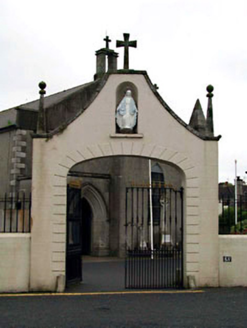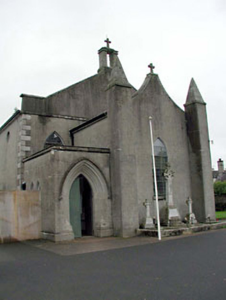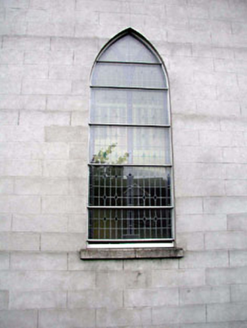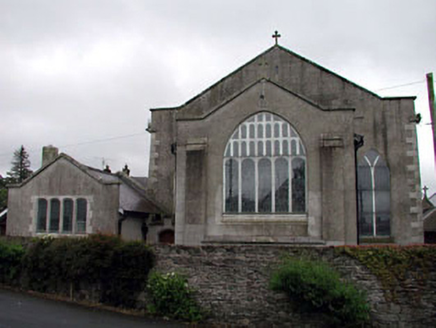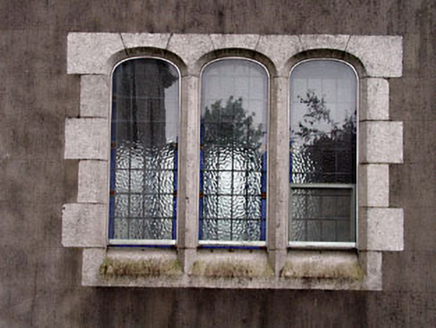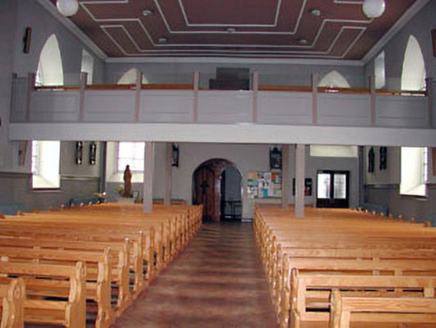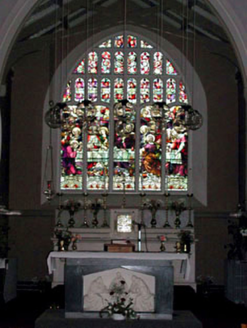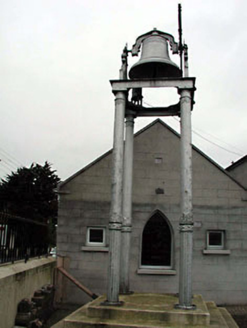Survey Data
Reg No
11820001
Rating
Regional
Categories of Special Interest
Architectural, Artistic, Historical, Social
Original Use
Church/chapel
In Use As
Church/chapel
Date
1815 - 1825
Coordinates
292647, 209941
Date Recorded
03/01/2003
Date Updated
--/--/--
Description
Detached four-bay double-height Catholic church, built 1820, on a rectangular plan comprising three-bay double-height nave opening into single-bay double-height chancel (north); single-bay double-height "narthex" (south) with single-bay single-storey flat-roofed porch. Renovated, 1990, with sanctuary reordered. Repaired, 1991. Pitched slate roofs including pitched slate roof (north), clay ridge tiles, cut-granite coping to gables including cut-granite coping to gable to entrance (south) front with Cross finial-topped cut-granite bellcote to apex, and replacement uPVC rainwater goods on cut-granite eaves. Replacement rendered, ruled and lined walls with repointed cut-granite quoins to corners; rendered, ruled and lined walls ("narthex") with cut-granite pyramid-topped rendered, ruled and lined piers to corners. Lancet window openings with cut-granite sills, and concealed dressings framing storm glazing over fixed-pane fittings having leaded stained glass panels. Pointed-arch window opening (north) with storm glazing over fixed-pane fittings having leaded stained glass panels. Lancet window opening ("narthex") with cut-granite sill, and concealed dressings framing storm glazing over fixed-pane fittings having leaded stained glass panel. Interior including vestibule (south); round-headed door openings into nave with timber boarded doors; full-height interior with timber panelled gallery (south) on paired posts, central aisle between cruciform-detailed timber pews, paired Gothic-style stations between stained glass memorial windows (1872; 1873), moulded plasterwork cornice to ceiling, and carpeted stepped dais to sanctuary (north) reordered, 1990, with pointed-arch chancel arch framing replacement panelled altar (1990) below stained glass "North Window" (1918). Set in landscaped grounds with rendered, ruled and lined stepped boundary wall to perimeter having rounded coping supporting cast-iron railings.
Appraisal
A church representing an important component of the built heritage of Ballymore Eustace with the architectural value of the composition, one showing the hallmarks of a period of construction coinciding with the gradual dismantling of the Penal Laws in anticipation of the Roman Catholic Relief Act, 1829, confirmed by such attributes as the compact rectilinear plan form; the disproportionate bias of solid to void in the massing compounded by the slender profile of the openings underpinning a "medieval" Gothic theme; the elegant Perpendicular Gothic "North Window" lighting the chancel; and the bellcote embellishing the roof as a picturesque eye-catcher in the landscape. Having been well maintained, the form and massing survive intact together with quantities of the original fabric, both to the exterior and to the interior where stained glass (1872; 1918) attributable to Lucien Leopold Lobin (1837-92) of Tours and Earley and Company (fl. 1861-1975) of Dublin highlights the artistic potential of a church making a pleasing visual statement in an urban street scene.
